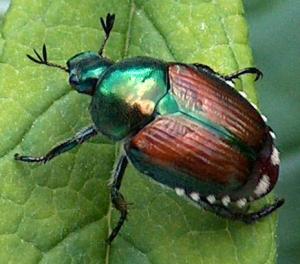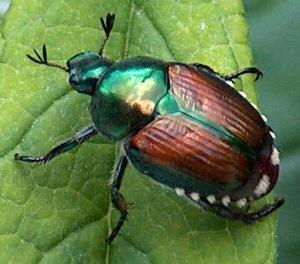Have you ever had the snow finally disappear from your lawn, only to find it riddled with mole holes? Or the dread that starts each June as you watch out your window at the gold and green Japanese Beetles reducing your prized strawberries to shreds?
They may seem like just two of the many complaints gardeners in Central Ontario face during the growing season, but they have a lot more in common than you think. 
In the case of moles, it is not the rodents themselves that are the problem, but a sign of something more sinister lurking beneath your lawn. The moles are drawn to your property by the sound of grubs; the tiny white larvae gardeners universally dislike that make their home in the soil and feed on the roots of your grass and other plants. This poses the obvious issue of the health of your lawn, with the first signs of a grub infestation often mistaken for drought stress. As the infestation continues, patches of your lawn will wilt and turn brown.
In extreme cases the sod will be easily removed from the soil (as the root system has been completely depleted).
The Japanese Beetles on the other hand, are simply the adult form of the grubs under your lawn. Most gardeners in Central Ontario know them well by the damage they inflict on all manner of flowers and the leaves and fruit of edible plants. With a severe enough infestation, even the best traps cannot catch all the beetles and many gardens are destroyed in only a matter of weeks.
 After emerging in summer to feed on our fruit and flowers, the Japanese beetles return to the soil to deposit their eggs. Once the eggs hatch (usually in September), the larvae burrow deep underground to survive the winter. When the Spring arrives and the ground thaws, the grubs move towards the surface, attracting the moles, and the cycle repeats itself once more.
After emerging in summer to feed on our fruit and flowers, the Japanese beetles return to the soil to deposit their eggs. Once the eggs hatch (usually in September), the larvae burrow deep underground to survive the winter. When the Spring arrives and the ground thaws, the grubs move towards the surface, attracting the moles, and the cycle repeats itself once more.
So what can you do to remove both the grubs and the adult beetles from your property? The most effective route would be to stop the beetles in the larvae (grub) stage before they can become a nuisance. The best method would also be one that is effective at controlling the grub population, yet that also poses no hazard to your lawn, pets and children!
The answer?
Nematodes! These are a natural, environmentally friendly option that not only works on Japanese beetle grubs but many other species as well. For the rundown on what nematodes are and how to use them, check back tomorrow for part two!
